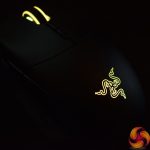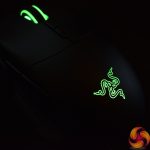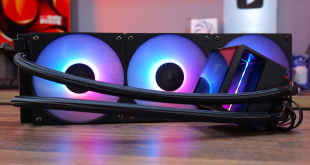To test the Basilisk, I used it as my daily driver for two weeks. During this time, I played games, edited photos and used it for general office duties as well.
Software
Note: If the gallery above is not displaying properly, please disable AdBlock as it is known to interfere with our display code.
Starting off with the software aspect of the mouse, the Basilisk supports Synapse 3. This software is still in beta, and only supports certain Razer products, but it is pretty fleshed-out and worked well for me while I was using the Basilisk.
Broadly speaking, it does seem to be very similar to Synapse 2, but with a more modern UI. There are a few new features to mention, though. Starting with HyperShift, this is very similar to Roccat's EasyShift [+] technology – essentially, users programme one of the mouse's 9 programmable buttons to act as a modifier button, and then an extra layer of secondary functions can be applied to each button. It is a nifty way to essentially double the amount of functions that can be mapped to the mouse.
Other than that, the Chroma studio is also worth touching on. This is for those who are not content with the preset lighting options and want to create their own effects. You can stack different effects on top of each other, choose different speeds and customise the scroll wheel and Razer logo zones separately. It's a neat way to get more customisation out of the mouse's lighting.
However, my biggest issue with Synapse 3 is that is does not support quite a few of Razer's other products. For example, I am currently using a BlackWidow Chroma V2 TE keyboard as my daily driver, and the keyboard only works with Synapse 2. This means I have to have both programs installed on my computer, and it also means I cannot synchronise the lighting between the two products. Considering Razer's Chroma ecosystem is a fairly significant feature of their modern peripherals, that is quite disappointing. Eventually Synapse 3 will support Razer's other peripherals, but for now I do find it frustrating that the company is designing certain products to work with the software, while other products have to rely on an older version of Synapse.
Lighting
Note: If the gallery above is not displaying properly, please disable AdBlock as it is known to interfere with our display code.
Moving onto the Basilisk's lighting, the overall effect is very similar to that of the DeathAdder Elite. That's quite a good thing, though, as the colours are bright, vibrant and also very accurate. However, I would've liked to see a bit more innovation with the lighting – aside from the ability to customise the lighting effects, it doesn't feel very special. Perhaps an LED strip down the side might add a bit more interest, but overall there is nothing we haven't seen before when it comes to the Basilisk's RGB lighting.
Comfort and performance
Now, let's move onto physically using the mouse.
Starting with comfort, I can say I immediately appreciated the large thumb-rest on the left-hand side of the mouse. It is perfectly positioned (for my hand, at least) and provides that bit of extra support you don't get from the DAE. With my preferred claw-grip, my index and middle fingers also sat perfectly aligned with the LMB and RMB buttons, while the curve of the Basilisk fits right into my palm.
However, what lets the Basilisk down in terms of its design is the right-hand side. I can appreciate comfort is a very subjective area, but for me, the right-hand side of the mouse slopes down far too steeply, and that leaves my fourth and pinky fingers resting almost entirely on my mouse pad. This is not a problem when gaming for an hour or two, but I sit at my desk all day – after several hours, my fingers do feel a bit rough from being dragged against the mouse pad the whole time.
If the right-hand side was less flat I think this problem would be solved. However, as it is, the Basilisk doesn't quite tick all of my boxes in terms of comfort.
Another subjective area, but potentially a problematic one, is mouse weight. At 107g (not including cable) the Basilisk is a fair bit heavier than other FPS mice like the HyperX Pulsefire or SteelSeries Rival 310. For me, it did take a bit of getting used to, but I am not too fussy about the weight of my mouse. Some gamers are, though, and I can imagine 107g being too much for plenty of people out there.
Moving on, the Basilisk's DPI clutch is also worth touching on, and I think the implementation of this idea is brilliantly done. There's no denying a sniper button is a useful feature, but usually such buttons are placed right in the middle of the mouse's side – as per the ASUS ROG Gladius II and the Corsair M65 Pro – and they can easily get in the way. Razer's solution is to have the button at the top end of the mouse, but to have it triggered by a small clutch/paddle.
Two different sizes of paddle are included – the one installed by default is longer, and I found my thumb would rest against it all the time, causing accidental presses. The shorter paddle is perfect, though – it is within easy reach of my thumb, but I won't accidentally press it at a crucial moment. It's quite a simple idea really, but it is done very well.
Other than that, having adjustable scroll wheel resistance is another interesting idea. In practice, you will likely set it once and not touch it again, but it does allow each user to get the settings just right for them, giving the Basilisk a more personal feel than something that is completely off-the-shelf. For reference, at its ‘loosest', the wheel is very fast, with no distinct steps – very similar to Logitech's Infinite Scroll. At the tightest setting, each step is very noticeable and you won't accidentally scroll if you don't want to. Most people will probably find their ideal setting somewhere in between the two.
In terms of actual sensor performance, Razer's optical 5G sensor is as good as ever – I can't say I noticed any difference in tracking or response times between the Basilisk and the DAE, and that is certainly a very good thing. In short, I has no issues with the sensor.
Lastly, the RMB and LMB switches are worth discussing. Coming directly from the HyperX Pulsefire I did find the clicks to be a bit heavier and more tactile – the Pulsefire's switches are just a little bit lighter and faster. However, that's not to say one is better than the other as a lot of it is personal preference. Speaking for myself, though, the Basilisk does feel very satisfying to click with.
 KitGuru KitGuru.net – Tech News | Hardware News | Hardware Reviews | IOS | Mobile | Gaming | Graphics Cards
KitGuru KitGuru.net – Tech News | Hardware News | Hardware Reviews | IOS | Mobile | Gaming | Graphics Cards



















Razer mice and keyboards are always nice spec wise, use a good spec base for switches/sensors and usually aren’t overly gaudy in terms of design, logo aside. Where they’re let down is 3 key areas:
1) Software. It’s just plain bad, it’s unnecessarily resource heavy, requires a login/server connection and isn’t completely user friendly.
2) Durability. Razer products often feel nice to use, but many don’t stand the test of time, and suffer some form of degradation (double clicking, dead switch, weak cable connection on wired devices). This particular problem is something that tends to not crop up in reviews as it’s something that happens months into use, a window far too large for any prospective new product review. It’s a long running problem with a very large number of their products, even into their laptop line (see Linus’ vid about their 10 Razer Blades they bought for their office, 8 were either replaced or in need of repair within a year of purchase, that’s pretty damning). This leads on to:
3) Customer Service. Razer are (in)famous for having some of the worst warranty and replacement services in gaming hardware, up there with the likes of Asus. If you do plan to get a Razer product, do so through a trusted retailer with a good reputation for handing device issues/rma requests and not through Razer’s own store.
If they could polish their software and improve their build quality, in all likelihood problem #3 would greatly diminish as there’d be less stress on their CS/RMA departments. I like the design/feature set of many of Razer’s products, but the risk and associated price tag that comes with them is too much for me to take on. Personally, it stops me ever recommending their hardware to folks.